Courtesy: Dr Ken Ono & Will Tenpas
Wearable sensors are everywhere. Over half a million diabetics in North America alone wear a glucose monitor paired with an insulin pump to manage their condition, and millions more wear smartwatches and fitness trackers to record and monitor health-related metrics. The idea of wearable sensors in healthcare has gone from revolutionary to ubiquitous. And in sports, tools from sleep trackers to golf club swing speed monitors have moved from a niche to the norm. With World Aquatics allowing wearables in competition (as of January 2023), swimming is now on track to benefit from these technological breakthroughs as well.
Here we highlight the impact swimming’s new wearable – eo SwimBETTER – can have on a swimmer, an impact that contributed to one of the most impressive success stories out of a historic Paris Olympics.
While there was rampant speculation going into the 800m free, nearly all of it centered around the brewing battle between Ariarne Titmus and world record holder Katie Ledecky. Could Ledecky win her fourth gold in a row in the event, or would Titmus put a stop to her dominance?
At the start of the final, this speculation made sense. Ledecky and Titmus burst out to an early lead, while American Paige Madden flipped at the first 50m in an inauspicious sixth place, already a second behind Ledecky and Titmus. At the halfway point, Madden lurked in fifth, far from podium position. But suddenly and seemingly out of the blue, she surged into third at the 550m mark. Madden didn’t just make up ground on those battling for third – she closed in on the veteran Ledecky and Aussie superstar Titmus.
By 700m, Madden was in a strong position for a podium spot and ultimately finished in 8:13.00 – splitting an exact even 4:06.5/4:06.5 for the Olympic bronze medal. Her time secured her place as the fourth-fastest 800m performer of all time, behind the likes of Ledecky, Titmus, and Summer McIntosh. The highly anticipated showdown between Ledecky and Titmus lived up to the hype, with the American edging out the Aussie star for a fourth consecutive gold medal. For some of us, the race had a glorious ending, when the iconic Olympic champion invited her friend and teammate to share the top step on the podium for their national anthem.
Much like her 800m, Madden did not start the Olympic Year with a bang. After failing to make the 2023 US team for Worlds in Fukuoka, she nearly retired from the sport, ultimately deciding to aim for a spot on her second US Olympic team.
She decided to do this at Arizona State University as a member of Bob Bowman and Herbie Behm’s pro group, while continuing to work with Dr. Ken Ono, a mathematician and performance analyst at the University of Virginia. Nine months before the U.S. Olympic Trials, Madden has a best time of 8:32 – a time that won’t just fail to medal but would’ve finished more than 12 seconds adrift of a US Olympic spot in 2021. So, she looked for change.
In the lead-up to the Olympic Trials, Madden began training with eo SwimBETTER. She is tested by Dr. Ono’s UVA based analytics group, and they identified multiple areas of opportunity, which (spoiler alert) ultimately helped her cut more than one second per lap in the 800m free. To find where she can be better, she raced a 200m free time trial wearing the eo SwimBETTER handsets.
Using eo SwimBETTER’s Stroke Path and Force Field data, the team observed the propulsive force of Madden’s left arm dropped by approximately 30% as she fatigued. The cause? Instead of pulling back, her catch turned almost entirely vertical, pushing the water downwards, instead of propelling her forwards.
While Madden has a nearly perfect stroke when not racing a competitor, the team recognized that Olympic races amplify stress, with the 800m free being a grueling eight-minute game of physical and mental chess. So, they set up race simulations with a varsity D1 swimmer in fins to push Madden at critical points. The eo SwimBETTER data highlighted, that when challenged in intense competition, Madden’s arm started crossing over, resulting in her force going out to the left instead of in the forward propulsive direction. Video analysis linked this pattern to her breath and her arms having to compensate for a lack of body rotation and looking at her competitor. Correcting this tendency had the potential to result in huge time drops.
With eo SwimBETTER’s insights, Madden retested the following day under the same circumstances and was able to vastly improve her numbers in just 24 hours, going from losing ~30% of her power to actually gaining propulsive power as the race went on.
Madden said, “When I first saw the eo SwimBETTER data, I was honestly shocked. I didn’t feel like my arm was crossing over, but it’s so obvious and the data doesn’t lie. Once those inefficiencies were pointed out, I could focus my training exactly where it mattered. Within days, I was seeing improvement, and over time, it completely transformed my performance.”
Over the next two months, Madden worked hard to ingrain the adjustments so that come race day she was ready. While she was perfectly capable of making the adjustments, she would have had no idea to target those specific areas of her technique without eo SwimBETTER highlighting these inefficiencies. Even precise video could not identify the subtle changes that an athlete as elite as Paige needed to make. Furthermore, these tests played an important role in devising her race strategy for the 800m – trying, and succeeding, to even split the race with newfound faith that she would catch many of the other Olympians who leapt out ahead of her in the opening laps.
The results of these changes speak for themselves.
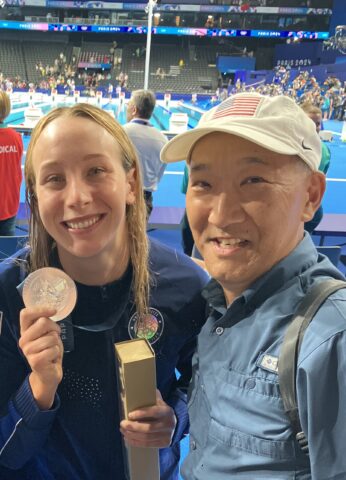
Paige Madden with Dr Ken Ono after the 4×200 freestyle relay medal ceremony in Paris.
About the Authors:
Ken Ono is the STEM Advisor to the Provost and the Marvin Rosenblum Professor of Mathematics at the University of Virginia. He is also a professor by courtesy of data science and a professor affiliate in statistics. In the 1980s he raced bicycles, and from 2012-2014 he competed as a member of age group Team USA in triathlon. He has served as a consultant for dozens of US National Team members and Olympic medalists.
Will Tenpas recently completed a master’s degree in data science at the University of Virginia. He graduated from Duke University with a B.S.E. in mechanical engineering in 2023, where he was also a four-year member of the varsity swim team and two-time captain.
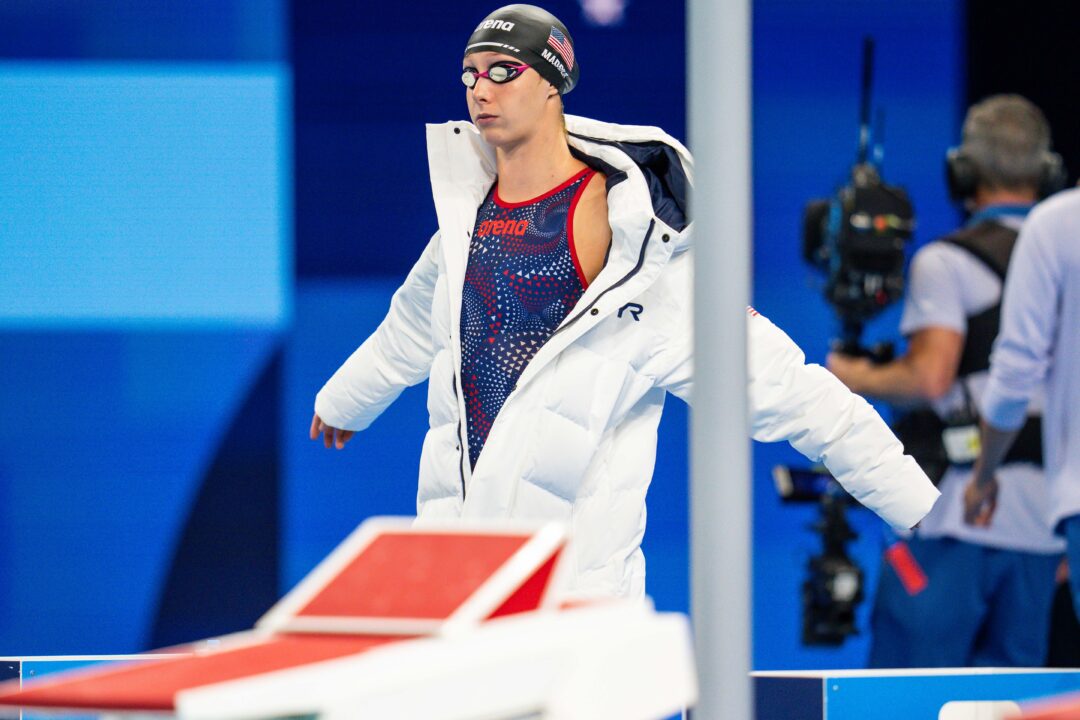

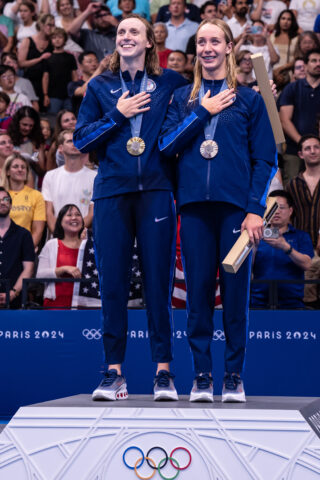
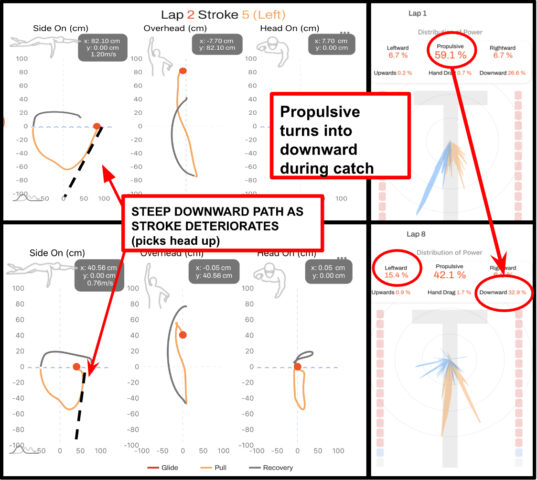
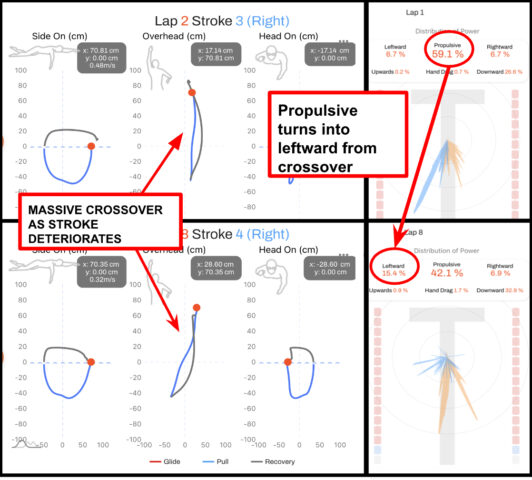
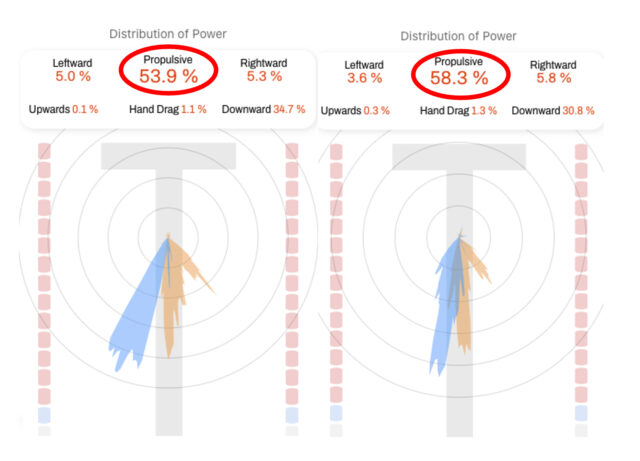
Ono is doing some revolutionary inclusion with his work.
P.S isn’t this the problem that Bella Sims discussed in a swim swam interview…elbow dropping and losing power?
yes, exactly. She is also back on track and it will be so fun to see her race this season!
Where is the disclaimer that this is a paid advertisement???
Would love to see some validity data for these handsets. The brief masters thesis Eo has highlighted online shows that the handsets poorly track stroke/minute metrics, indicating IMU units have very poor accuracy (calling into question the stroke pattern metrics), the pressure tests had high RMSE’s (calling into question the force metrics), and the manufacturer did not disclose any way of looking at raw data to the researchers. If one could simply hold the sensor at a known depth, the accuracy of the pressure sensor (under no motion) could be calculated.
SMG, I am one of the developers of eo SwimBETTER. We had no engagement with, or request from, the Masters student to access the raw data.
These two papers may be of interest to you re the accuracy of the pressure sensors and the IMUs.
IMU https://www.eolab.com/content/files/2024/04/15/IMU_Assessment_on_eo_SwimBETTER_-_Pilot.pdf
Pressure https://www.eolab.com/content/files/2023/06/08/eo_SwimBETTER_Pressure_Sensor_Evaluation.pdf
Thanks, Kenneth. I appreciate the willingness to respond in public. I wish the Master’s student in question had as for more help/information at the time.
Unfortunately, Neither of those PDFs is a peer reviewed research paper with sound scientific methods. Nor do they actually provide any quantitative results, simply graphs with zoomed-out axes. Spinning a non-calibrated drill and dropping a non-weighted bucket into the water, without using gold-standard calibration equipment to compare the handset against, is 5th grade science. I’m not saying the handsets don’t work, the replicability of the figures within the app are meaningful and can be demonstrative of pattern changes over time. The ability to time sync a video with the data overlay just by recording… Read more »
Peer-reviewed studies are valuable, but they’re far from infallible. The process has significant flaws, including publication bias (favoring novel or positive results), the replicability crisis (many findings can’t be reproduced), conflicts of interest (especially when studies are funded by biased parties), and reviewer bias (human subjectivity). Additionally, practices like p-hacking or selective data reporting can skew results. Peer review ensures a study meets basic scientific standards, but it doesn’t guarantee truth or practical relevance. Critical thinking, not blind trust in the peer-review label, is essential when evaluating evidence.
Just so I’m clear, I believe there is a practical use case for the product having seen it in action and swam a 50 with the handsets. Here’s where I think methodologically could demonstrate that the handsets are a scientifically valid instrument and not just access to a coaching feedback storage app.
For positional validity: Affix the handsets to an oar, affix infrared reflectors to the oar, triangulate the position of the handset relative to the reflectors in calibrated space to determine the sensors actual position. Spin the oar in a circular motion at 20/30/40/50 strokes per minute to mimic a windmill stroke. Record with an infrared camera system which is synced with the handset’s positional output. Compare the… Read more »
Thanks for you comments; in the methods section for the pressure sensors you will see that the sensors were placed in a weighted bucket. We did use a support arm to hang the handsets away from the side of the pool. The cord used to suspend the bucket had been marked against a metal rule to get 1m increments. As you indicate the sensors should be left undisturbed for at least 30 seconds at each depth (0-4m); this was done (par 3 of the methods) . Measures were made on the way down and on the way up (par 3) to allow us to examine for any hysterisis (fig 1 shows the data from 1 handset/ 2 sensors).
I… Read more »
I’m with SMG here. As a scientist at an R1 myself… I’m pretty disappointed with these “papers”. If you are making the claim that your device is scientifically validated, sending a word doc with short summaries of results and not an actual PEER REVIEWED research paper, that is a massive red flag for consumers, coaches, and the science/engineering communities. The statistical reliability of the pressure paper is not very robust. I’d expect to see Bland-Altman analysis comparing it to a gold standard device before I could be convinced that this product is comparable. I’m not trying to come out here and say that there is no chance that the devices actually do what you claim, I’m saying that the scientific… Read more »
As much as I appreciate skepticism in the scientific process, there are a few issues with your reasoning here that warrant clarification:
1. Over-Reliance on Peer Review
• While peer-reviewed papers are useful, they are not the sole measure of scientific validity. Many groundbreaking innovations started with unpublished data or industry-validated results before making their way into journals. Dismissing results simply because they aren’t yet peer-reviewed ignores other valid forms of evidence.
2. Double Standards for Validation
• You mention the need for a Bland-Altman analysis against a gold standard. Fair enough—but what “gold standard” is universally accepted for pressure sensors in the specific context this device operates in? Demanding one without acknowledging its absence or… Read more »
Perhaps it’s Ken Ono who deserves the Golden Goggles award.
Did he swim the race for her? I get your point, but. 🥴
There is a “coach of the year” award. DeSorbo didn’t swim the race for any of his athletes either. Perhaps Ono is the secret sauce. Unfortunately, DeSorbo didn’t even give him a mention.
If you followed UVA extensively you would know that they work as a team and credit is shared generously. Always efforts to poke holes.
It would be pretty cool to have an “innovation in the sport” kind of award that could go to coaches, athletes, or other people who had a massive impact.
Agreed. I know Pan and Chalmers also used the eo SwimBETTER, and I’m sure quite a few others did as well. The way they used it in race simulations with Paige was really cool. I just thought of it as something to use in occasional sets, but it makes so much sense to race with it too.
He certainly deserves something. This is incredible work.